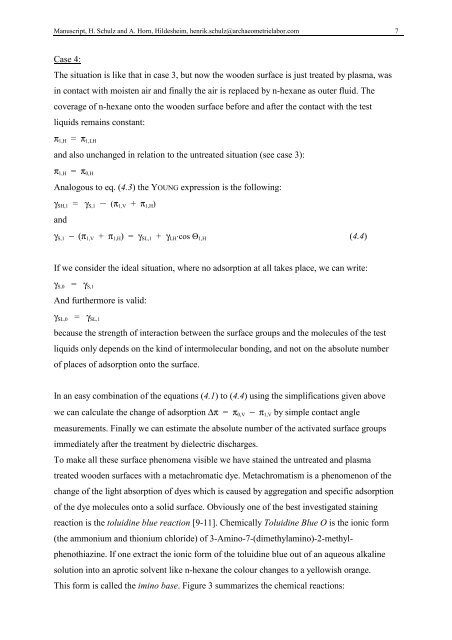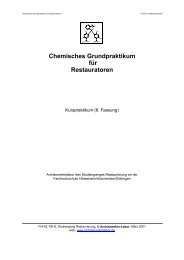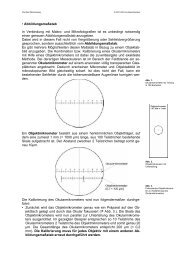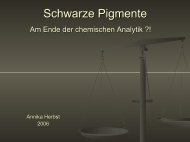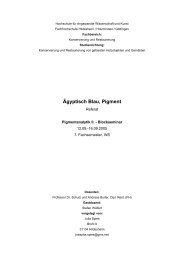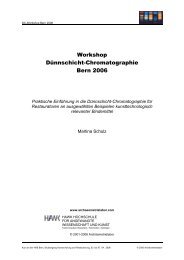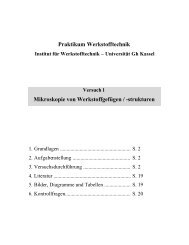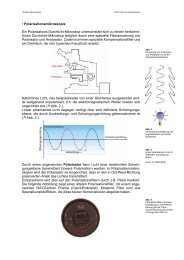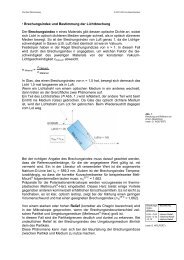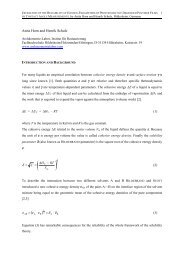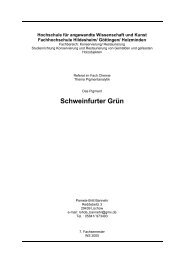Henrik Schulz* and Anita Horn, Archäomertrie-Labor der HAWK ...
Henrik Schulz* and Anita Horn, Archäomertrie-Labor der HAWK ...
Henrik Schulz* and Anita Horn, Archäomertrie-Labor der HAWK ...
Create successful ePaper yourself
Turn your PDF publications into a flip-book with our unique Google optimized e-Paper software.
Manuscript, H. Schulz <strong>and</strong> A. <strong>Horn</strong>, Hildesheim, henrik.schulz@archaeometrielabor.com 7<br />
Case 4:<br />
The situation is like that in case 3, but now the wooden surface is just treated by plasma, was<br />
in contact with moisten air <strong>and</strong> finally the air is replaced by n-hexane as outer fluid. The<br />
coverage of n-hexane onto the wooden surface before <strong>and</strong> after the contact with the test<br />
liquids remains constant:<br />
π1,H = π1,LH<br />
<strong>and</strong> also unchanged in relation to the untreated situation (see case 3):<br />
π1,H = π0,H<br />
Analogous to eq. (4.3) the YOUNG expression is the following:<br />
γSH,1 = γS,1 " (π1,V + π1,H)<br />
<strong>and</strong><br />
γS,1 − (π1,V + π1,H) = γSL,1 + γLH⋅cos Θ1,H (4.4)<br />
If we consi<strong>der</strong> the ideal situation, where no adsorption at all takes place, we can write:<br />
γS,0 = γS,1<br />
And furthermore is valid:<br />
γSL,0 = γSL,1<br />
because the strength of interaction between the surface groups <strong>and</strong> the molecules of the test<br />
liquids only depends on the kind of intermolecular bonding, <strong>and</strong> not on the absolute number<br />
of places of adsorption onto the surface.<br />
In an easy combination of the equations (4.1) to (4.4) using the simplifications given above<br />
we can calculate the change of adsorption ∆π = π0,V − π1,V by simple contact angle<br />
measurements. Finally we can estimate the absolute number of the activated surface groups<br />
immediately after the treatment by dielectric discharges.<br />
To make all these surface phenomena visible we have stained the untreated <strong>and</strong> plasma<br />
treated wooden surfaces with a metachromatic dye. Metachromatism is a phenomenon of the<br />
change of the light absorption of dyes which is caused by aggregation <strong>and</strong> specific adsorption<br />
of the dye molecules onto a solid surface. Obviously one of the best investigated staining<br />
reaction is the toluidine blue reaction [9-11]. Chemically Toluidine Blue O is the ionic form<br />
(the ammonium <strong>and</strong> thionium chloride) of 3-Amino-7-(dimethylamino)-2-methylphenothiazine.<br />
If one extract the ionic form of the toluidine blue out of an aqueous alkaline<br />
solution into an aprotic solvent like n-hexane the colour changes to a yellowish orange.<br />
This form is called the imino base. Figure 3 summarizes the chemical reactions:


